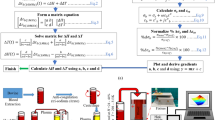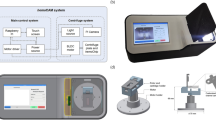Abstract
An on-line haematocrit measurement in extracorporeal circuits might be useful under some clinical circumstances (e.g. haemodialysis or cardiac surgery). As no such measurement exists, a device has been developed that makes it possible to detect haematocrit (Ht) continuously without a loss of blood. It is a multi-frequency system for the detection of electrical conductivities. The aim of this study was to investigate whether this device can measure Ht alterations properly. Ht alterations were induced by adding pure mannitol and 20% mannitol to fresh human blood. Furthermore, the effect of both mannitol substances on the intracellular ion content, intracellular conductivity and Ht were investigated. Alternations in Ht were established by the addition of 1000, 800, 600, 400, 200 and 0 mg of pure mannitol to 10 ml of fresh human blood, and 3.0, 2.5, 2.0, 2.0, 1.5, 1.0, 0.5 and 0 ml of 20% mannitol to fresh human blood until a total volume of 10 ml was achieved. Although their effects were significantly different, pure mannitol and 20% mannitol both caused a reduction in mean cellular volume, and thus in Ht. A highly significant correlation was found between Ht and intracellular conductivity (r=0.90, p<0.001). In addition to these effects, addition of pure mannitol and 20% mannitol had different effects on the intracellular ion content. Pure mannitol caused an increase in intracellular ion content due to a transcellular ion shift, whereas 20% mannitol induced a decrease. From this study, it can be concluded that the multi-frequency conductivity method observes changes in Ht (and intracellular fluid volume) in an accurate manner. Changes in intracellular ion content of erythrocytes depend on the sort of mannitol substance that is added. The intracellular ion concentration can be calculated from measured intracellular conductivity and Ht. The total number of intracellular ions can be derived from intracellular conductivity and the number of erythrocytes.
Similar content being viewed by others
References
Corten, P. M. J. (1980): ‘Continuous registration of segmental stroke volume and wall movement of the left ventricle by means of electrical impedance measurements with an intraventricular multi-electrode catheter.’ Thesis, University Nijmegen, The Netherlands
Fromter, E. (1987). ‘Cellular handling of water,’Kidney Int., suppl.,21, pp. 2–7
Goovaerts, H. G., De Vries, F. R., Meijer, J. H., De Vries, P. M. J. M., Donker A. J. M., andSchneider, H. (1988): ‘Microprocessor-based system for measurement of electrical impedances during haemodialysis and in postoperative care,’Med. & Biol. Eng. & Comput.,26, pp. 75–80
Hanai, T. (1968): ‘Electrical properties of emulsions’in Sherman, Ph, (Ed.) ‘Emulsion science’ (Academic Press, London) pp. 354–477
Kanai, H., Haeno, M., andSakamoto, K. (1982): ‘Electrical measurement of fluid distribution in legs and arms: estimation of extra-cellular and intra-cellular fluid.’ IEEE Conf. on Frontiers of Engineering in Health Care, pp. 273–276
Lilien, O. M., andAndaloro, V. A. (1970) ‘Mannitol and ionic shifts,’Invest. Urol.,7, pp. 467–477
Meijer, J. H., De Vries, P. M. J. M., Goovaerts, H. G., Oe, P. L., Donker, A. J. M., andSchneider, H. (1989): ‘Measurement of transcellular fluid shift during hemodialysis. Part I, Method,’Med. & Biol. Eng. & Comput.,27, pp. 147–51
Moreno, M., Murphy, C., andGoldsmith, C. (1969): ‘Increase in serum potassium resulting from administration of hypertonic mannitol and other solutions,’J. Lab. Clin. Med.,73, pp. 291–298
Moulik, S. P. andKhan, D. P. (1974): ‘Conductometric evaluation of interactions of electrolytes with d-glucitol, d-glucose, glycerol, d-mannitol, and sucrose,’Carbohydr. Res.,36, pp. 147–157
Nemethy, G. andScheraga, H. A. (1962): ‘Structure of water and hydrophobic binding in proteins. II. A model for the thermodynamic properties of aqueous solutions of hydrocarbon’,J. Chem. Phys.,36, pp. 3401–3417
Ogston, A. G., Preston, B. N. andWells, J. D. (1973): ‘On the transport of compact particles through chain polymers,’Proc. R. Soc. Lond.,A333, pp, 297–316
Olthof, C. G., De Vries, P. M. J. M., Kouw, P. M., Oe, P. L., Schneider, H., De Lange, J. J., andDonker, A. J. M. (1993): ‘A non-invasive conductivity method for detection of dynamic body fluid changes: in vitro and in vivo validation,”Nephrol. Dial. Transplant,8, pp. 41–46
Schwan, H. P. (1957): ‘Electrical properties of tissue and cell suspensions’in:Lawrence, J. H., andTobias, C. A. ‘Advances in biological and medical physics, Vol V’ (Academic Press, New York) pp. 147–209
De Vries, P. M. J. M. (1989): ‘Determination of intracellular and extracellular fluid volume by means of non-invasive conductivity measurements; Method, in vitro validation and clinical application during haemodialysis and haemofiltration.’ Thesis, Free University, Amsterdam (Free University Press, The Netherlands)
De Vries, P. M. J. M., Meijer, J. H., Vlaanderen, K., Visser, V., Oe, P. L., Donker, A. J. M., andSchneider, H. (1989): ‘Measurement of transcellular fluid shift during haemodialysis. Part 2: in vitro and clinical validation,’Med. & Biol. Eng. & Comput.,27, pp. 152–158
Whittam, R. (1964): ‘Classical osmotic phenomena’in:Barcroft, H., Davson, H., andPaton, W. D. M. (Eds.) ‘Transport and diffusion in red blood cells’ (Edward Arnold Publishers Ltd., London) Chap. 5, pp. 44–62.
Zheng, E., Shao, S., andWebster, J. G. (1984): ‘Impedance of skeletal muscle from 1 hz to 1 MHz,’IEEE Trans.,BME-31, pp. 477–481
Author information
Authors and Affiliations
Rights and permissions
About this article
Cite this article
Olthof, C.G., Kouw, P.M., Donker, A.J.M. et al. Non-invasive conductivity technique to detect changes in haematocrit:in vitro validation. Med. Biol. Eng. Comput. 32, 495–500 (1994). https://doi.org/10.1007/BF02515307
Received:
Issue Date:
DOI: https://doi.org/10.1007/BF02515307




